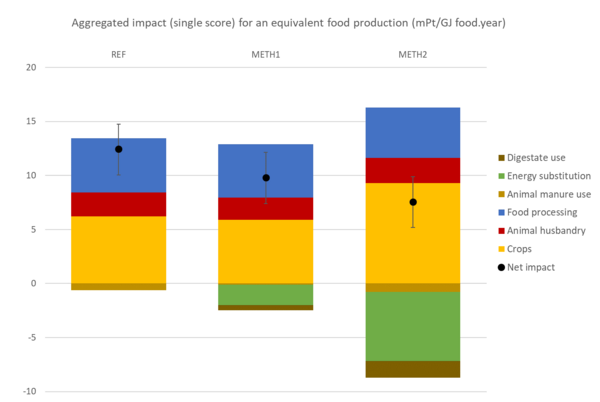Capturing the effects of crop diversification beyond the field is a very complex issue, as these indirect effects encompass several dimensions (environmental, social, economic), several actors (farmers, retailers, processors, etc.) and several scales (from the field to the value chain and territory), which interact with each other. This article illustrates how the Life Cycle Assessment (LCA) methodology was used in the DiverIMPACTS project to capture indirect effects of crop diversification. The LCA methodology of system expansion with substitution was used, which looks at the supply of agricultural products beyond the field, down the agri-food chain, to the end user. This enables the comparison of more or less diversified systems in terms of impacts for an equivalent function (food) delivered to the end user (people). Three analyses were conducted based on three DiverIMPACTS case studies.
The first LCA compares the impact of conventional pure durum wheat pasta vs. blended hemp pasta for an equivalent protein and energy supply to human diets (based on case study 9 in Sicily). Results show that the production of protein or energy from conventional pure durum wheat pasta has an overall impact 1.6 times higher than the same amount of protein or energy supplied by blended pasta. This is due to lower impacts associated with producing hemp. It is also due to avoided impacts thanks to co-products being used in human food (hempseed oil) and animal feed (wheat bran and hemp meal) instead of olive oil and various feed ingredients in animal diets. This comparison illustrates the advantages of diversifying a rotation with the introduction of hemp for blended pasta production.
A second LCA compares the impact of a reference system with forage wheat vs. a diversified system with an intercropping of pea and bread-quality wheat for an equivalent protein and energy supply to human diets (based on case study 17 in Wallonia). For an equivalent protein supply to human diets, the diversified system displayed an environmental impact 1.2 times lower than the reference system. In terms of energy supply, the diversified system showed half the impact of the reference system.
A third LCA compares the impact for an equivalent energy supply to human diets of three systems: one reference producing food and feed crops, and two diversified systems with food and feed crops, and energy crops for biogas production (based on case study 13 in France). The diversified systems required additional land to produce the same amount of food compared to the reference system. However, the use of biogas for electricity and heat production offset the impacts of this additional land requirement: the two diversified systems with energy crops had impacts 1.3 and 1.6 times lower than the reference system for equivalent food production. This indicates that the introduction of energy crops into rotations is possible without increasing the environmental impact of food production.
These LCA studies illustrate the potential of LCA to capture the indirect effects of crop diversification all along the value chain to the end user. However, data availability, the choice of the functional unit and the hypotheses concerning substitution processes are critical choices and underline the importance of carrying out sensitivity analyses to test the robustness of the conclusions.

 toccare e scorrere fino al comando Aggiungi alla schermata iniziale.
toccare e scorrere fino al comando Aggiungi alla schermata iniziale.